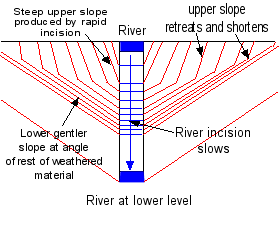Flattening of the sides of a V shaped valley.
Please start at Evolution.html
Conditions:
(a) Channelised flow starts on a rock surface.
(b) The rock is resistant and strong enough to support a vertical slope.
(c) River incision is rapid to begin with but slows.
(d) The valley side is subject to physical weathering and the free fall of the weathered debris into the river.
(e) The angle of rest of the weathered debris is 45 degrees.
(f) Once the valley side is at the angle of rest of the weathered debris continued river incision will trigger shallow slides in the weathered debris.
Explanation of the simulation:
(a) The river is shown in blue, the rock in green and weathered fragments in yellow.
(b) The rock is divided up into rectangles to represent the fragments it weathers to. The angle of rest of the weathered material is given by the diagonal of the rectangle. The dimensions of the rectangles can be varied to give the angle of rest required.
(c) Each click on the manual simulation represents a constant unit of time.
(d) The incision is shown in stages.
(e) Initially incision is rapid. Weathering and free fall of the weathered debris form a steep slope.
(f) As incision slows a gentler lower slope is formed.
(g) Once the lower slope is at the angle of rest of the weathered debris it cannot decline to a lower angle for the conditions stated.
(h) As the valley deepens the upper slope retreats parallel to itself by physical weathering and free fall of debris. The lower slope is lowered by shallow slides in the weathered debris triggered by the basal steepening produced by river incision. The slides work their way up the lower slope from the river.
(g) As the rate of incision slows the steep upper slope gets shorter and shorter as it retreats. The lower constant slope at the angle of rest of the weathered debris extends higher and higher and gets longer and longer. Eventually the valley side flattens to the angle of rest of the weathered debris.
The diagram below shows how a steep sided V-shaped valley becomes a gentler sided V-shaped valley:

I would suggest that the sides of most V-shaped valleys stand at the angle of rest of the weathered material or at the steepest slope a mechanically weak rock can support. A valley side with a uniform gradient is nearly always going to be one or the other.
|
